届本科毕业论文外文翻译模板(说明版)
- 格式:doc
- 大小:80.50 KB
- 文档页数:5
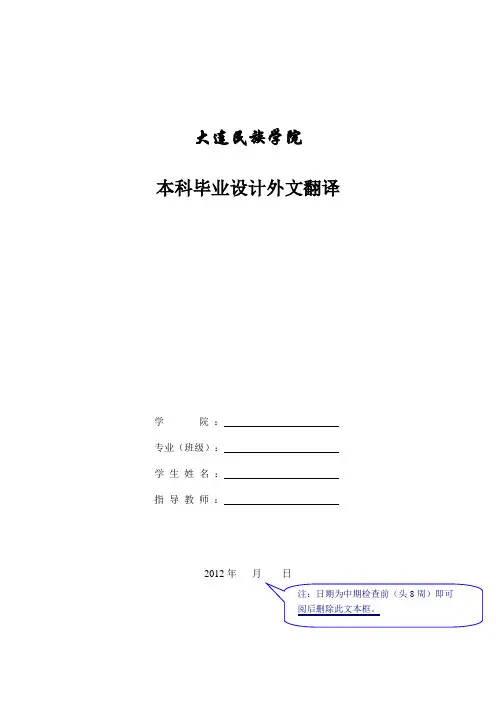
大连民族学院
本科毕业设计外文翻译
学院:
专业(班级):
学生姓名:
指导教师:
2012年月日
1
每名学生在毕业设计(论文)期间,应完成译文不少于3千汉字的外文资料翻译。
译文内容必须与毕业设计(论文)内容有关,原则上是近五年出版的期刊(不可翻译有中文译文的书籍或期刊)。
1.1译文正文格式
译文正文格式同毕业设计(论文)正文格式要求。
1.2 译文页眉页脚的编排
页脚要求同毕业论文页脚要求,一律用阿拉伯数字连续编页码。
页码应由正文首页开始,作为第1页。
封面不编入页码。
页码必须标注在每页页脚底部居中位置,宋体,小五。
无页眉。
1.3标题格式
各级标题格式同毕业论文中相关要求。
2 打印和装订说明
2.1 封皮
按照首页格式制作封面。
2.2 正文
单面打印。
2.3装订规范要求
装订时原文在前,译文在后,左侧装订。
译文必须于毕业设计(论文)中期检查前完成,交指导教师批改。
–1–。
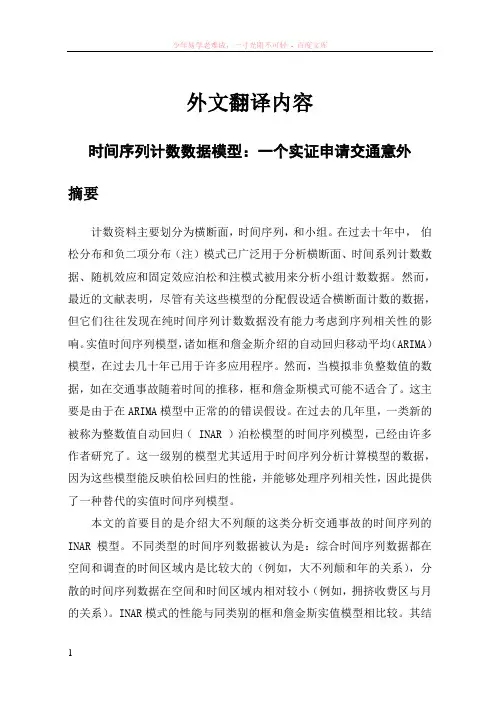
外文翻译内容时间序列计数数据模型:一个实证申请交通意外摘要计数资料主要划分为横断面,时间序列,和小组。
在过去十年中,伯松分布和负二项分布(注)模式已广泛用于分析横断面、时间系列计数数据、随机效应和固定效应泊松和注模式被用来分析小组计数数据。
然而,最近的文献表明,尽管有关这些模型的分配假设适合横断面计数的数据,但它们往往发现在纯时间序列计数数据没有能力考虑到序列相关性的影响。
实值时间序列模型,诸如框和詹金斯介绍的自动回归移动平均(ARIMA)模型,在过去几十年已用于许多应用程序。
然而,当模拟非负整数值的数据,如在交通事故随着时间的推移,框和詹金斯模式可能不适合了。
这主要是由于在ARIMA模型中正常的的错误假设。
在过去的几年里,一类新的被称为整数值自动回归( INAR )泊松模型的时间序列模型,已经由许多作者研究了。
这一级别的模型尤其适用于时间序列分析计算模型的数据,因为这些模型能反映伯松回归的性能,并能够处理序列相关性,因此提供了一种替代的实值时间序列模型。
本文的首要目的是介绍大不列颠的这类分析交通事故的时间序列的INAR模型。
不同类型的时间序列数据被认为是:综合时间序列数据都在空间和调查的时间区域内是比较大的(例如,大不列颠和年的关系),分散的时间序列数据在空间和时间区域内相对较小(例如,拥挤收费区与月的关系)。
INAR模式的性能与同类别的框和詹金斯实值模型相比较。
其结果表明,综合交通事故时间序列数据在系数估计方面和拟合优度的情况下,这些两类模式的性能是十分相似的。
这是因为在这种正常的相近的情况下,平均的计数是很准确的,ARIMA模型可以令人满意。
然而,INAR泊松模型的性能被发现有明显优于的ARIMA模型,因为在分散的时间序列数据的交通事故中,ARIMA模型的计数是在相对较低。
文章最后讨论了INAR 模型的局限性来处理的季节性和观测到的异质性。
1.绪论公路运输给社会带来了巨大的利益,但它也有直接和间接成本。
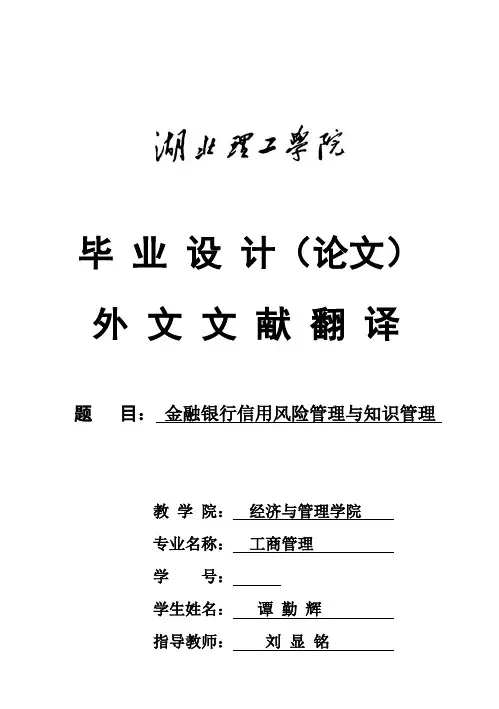
毕业设计(论文)外文文献翻译题目:金融银行信用风险管理与知识管理教学院:经济与管理学院专业名称:工商管理学号:学生姓名:谭勤辉指导教师:刘显铭2013 年05 月28 日Managing Credit Risks with Knowledge ManagementforFinancial BanksPan JinDepartment of EconomicsEconomics and Management School of Wuhan UniversityWuhan,Hubei ProvinceChinaAbstract-Nowadays,financial banks are operating in a knowledge society and there are more and more credit risks breaking out in banks.So,this paper first discusses the implications of knowledge and knowledge management, and then analyzes credit risks of financial banks with knowledge management. Finally, the paper studies ways for banks to manage credit risks with knowledge management. With the application of knowledge management in financial banks, customers will acquire better service and banks will acquire more rewards.Index Terms–knowledge management; credit risk; risk management; incentive mechanism; financial banksI.INTRODUCTIONNowadays,banks are operating in a“knowledge society”.So, what is knowledge? Davenport(1996)[1]thinks knowledge is professional intellect,such as know-what, know- be shared and communicated. The awareness of the importance of knowledge results in the critical issue of “knowledge management”.So, what is knowledge management? According to Malhothra(2001)[2], knowledge management(KM)caters to the critical issues of organizational adaptation, survival and competence in face of increasingly discontinuous environmental change. Essentially it embodies organizational processes that seek synergistic combination of data and information processing capacity of information technologies and the creative and innovative capacity of beings. Through the processes of creating,sustaining, applying, sharing and renewing knowledge, we can enhance organizational performance and create value.Many dissertations some special fields. Aybübe Aurum(2004)[3] analyzes knowledge management in software engineering and D.J.Harvey &R.Holdsworth(2005)[4]study knowledge management in the aerospace industry. Li Yang(2007)[5] studies knowledge management in information-based education and Jayasundara&Chaminda Chiran(2008)[6] review the prevailing literature on knowledge management in banking industries. Liang ping and Wu Kebao(2010)[7]study the incentive mechanism of knowledge management inBanking.There are also many papers about risks analysis and risks management. Before the 1980s, the dominant mathematical theory of risks analysis was to describe a pair of random vectors.But,the simplificationassumptions and methods used by classical competing risks analysis caused controversy and criticism.Starting around the 1980s, an alternative formulation of risk analysis was developed,with the identifiability. The new formulation is univariate risk analysis.According to Crowder(2001)[8], David&Moeschberger(1978)[9]and Hougaard(2000)[10],univariate survival risk analysis dominantly, which is based on the i.i.d assumptions(independent and identically distributed) or, at least, based on the independent failure assumption.Distribution-free regression modeling allows one to investigate the influences of multiple covariates on the failure, and it relaxes the assumption of identical failure distribution and to some extent, it also relaxes the single failure risk restriction. However, the independent failures as well as single failure events are still assumed in the univariate survival analysis. Of course,these deficiencies do not invalidate univariate analysis, and indeed, in many applications, those assumptions are realistically valid.Based on the above mentioned studies, Ma and Krings(2008a, 2008b)[11]discuss the relationship and difference of univariate and multivariate analysis in calculating risks.As for the papers on managing the risks in banks, Lawrence J.White(2008)[12]studies the risks of financial innovations and takes out some countermeasures to regulate financial innovations. Shao Baiquan(2010)[13]studies the ways to manage the risks in banks.From the above papers, we can see that few scholars Ⅰis introduction. SectionⅡanalyzes credit risks in banks with knowledge management. SectionⅢstudies ways for banks to manage credit risks with knowledgemanagement. SectionⅣconcludes.II.ANALYZING CREDIT RISKS IN BANKS WITHKNOWLEDGE MANAGEMENTA.Implication of Credit RiskCredit risk is the risk of loss due to a debtor’s non-payment of a loan or other line of credit, which may be the principal or interest or both.Because there are many types of loans and counterparties-from individuals to sovereign governments-and many different types of obligations-from auto loans to derivatives transactions-credit risk may take many forms.Credit risk is common in our daily life and we can not cover it completely,for example,the American subprime lending crisis is caused by credit risk,which is that the poor lenders do not pay principal and interest back to the banks and the banks do not pay the investors who buy the securities based on the loans.From the example,we can find that there are still credit risks,though banks banks includes tacit knowledge and explicit knowledge,which is scattered in different fields.For example, the information about the customers’income, asset and credit is controlled by different departments and different staffs and the information can’t be communicated with others. So it is necessary for banks to set up a whole system to communicate and share the information and knowledge to manage the risks.C.Setting up Incentive Mechanism and Encouraging Knowledge InnovationThe warning mechanism of credit risks depends on the incentive mechanism in banks,so, banks should take out incentive mechanism to urge staffs to learn more knowledge and work creatively to manage credit risks.We can show the incentive mechanism as Fig.1:Fig.1 The model of incentive mechanism with knowledge management From Fig.1,we can see there are both stimulative and punitive measures in the incentive model of knowledge management for financial banks.With the incentive mechanism of knowledge management in financial banks,the staffs will work managing credit risks with knowledge management.We can show them in Fig.2:Fig.2 The blocks of managing credit risksA.Distinguishing Credit RiskDistinguishing credit risks is the basis of risk management.If we can’t recognize the risks,we are unable to find appropriate solutions to manage risks.For example,the United States subprime crisis in 2007 was partly caused by that the financial institutions and regulators didn’t recognize the mortgage securitization risks timely.With knowledge management,we can make out some rules to distinguish credit risks,which are establishing one personal credit rating system for customers and setting up the data warehouse.We can use the system to analyze customers’credit index, customers’credit the changes of customers’property and income to recognize potential risks.B.Assessing and Calculating Credit RiskAfter distinguishing the credit risks,we should assess the riskexposure,risk factors and potential losses and risks, and we should make out the clear links.The knowledgeable staffs in banking should use statistical methods and model and the regulators should establish credit assessment system and then set up one national credit assessment system.With the system and the model of risk assessment,the managers can evaluate the existing and emerging risk factors,such as they prepare credit ratings for internal use.Other firms,including Standard &Poor’s,Moody’s and Fitch,are in the business of developing credit rating for use by investors or other third parties.TableⅠshows the credit ratings of Standard&Poor’s.TABLE ISTANDARD&POOR’S CREDITT RATINGSCredit ratings ImplicationsAAA Best credit quality,extremely reliableAA Very good credit quality,very reliableA More susceptible to economic conditionsBBB Lowest rating in investment gradeBB Caution is necessaryB Vulnerable to changes in economicCCC Currently vulnerable to nonpaymentCC Highly vulnerable to payment defaultC Close to bankruptD Payment default has actually occurredAfter assessing credit risks,we can use Standardized Approach andInternal Rating-Based Approach to calculate the risks.And in this article,we will analyze uncovered loan.To calculate credit risk of an uncovered loan,firstly,we will acquire the bo rrower’s Probability of Default(PD),Loss Given Default(LGD),Exposure at Default(EAD)and Remaining Maturity(M).Secondly,we calculate the simple risk(SR)of the uncovered loan,using the formula as following: SR=Min{BSR(PD)*[1+b(PD)*(M-3)]*LGD50,LGD*12.5} (1)Where BSR is the basic risk weight and b(PD)is the adjusting factor for remaining maturity(M).Finally,we can calculate the weighted risk(WR)of the uncovered loan,using the following formula:WR=SR*EAD (2)From(1)and(2),we can acquire the simple and weighted credit risk of an uncovered loan,and then we can take some measures to ’t repay the loans,banks can get the compensation from the insurance company.(3)Loans Securitization. Banks can change the loans into security portfolio,according to the different interest rate and term of the loans,and then banks can sell the security portfolio to the special organizations or trust companies.D.Managing Credit Risk and Feeding backA customer may acquire the customer’s credit information,credit the data the banks get.By assessing and calculating the risks of the customer,banks can expect the future behavior of the customers and provides different service for different customers. Banks can provide morevalue-added service to the customers who remedial after the risks broke out.In order to set up the warning and feeding back mechanism,banks should score credit of the customers comprehensively and then test the effectiveness and suitability of the measures,which banks use to mitigate risks.Finally, banks should update the data of the customers timely and keep the credit risk management system operating smoothly.IV.CONCLUSIONIn this paper,we first discuss the implications of knowledge and knowledge management.Then we analyze the credit risks of financial banks with knowledge management. Finally,we put forward ways for banks to manage credit risks with knowledge management.We think banks should set up data warehouse of customers’credit to assess and calculate the credit risks,and at the same time,banks should train knowledgeable staffs to construct a whole system to reduce risks and feed back.With knowledge management,banks can take out systemic measures to manage customers’credit risks and gain sustainable profits.ACKNOWLEDGMENTIt is financed by the of China(NO.06JC790032).REFERENCES[1]Davenport,T.H.et al,“Improving knowledge work processes,”Sloan Management Review,MIT,USA,1996,Vol.38,pp.53-65.[2]Malhothra,“Knowledge management for the new world of business,”New York BRINT Institute,2001, software engineering education,”Proceedings of the IEEE International Conference onAdvanced Learning Technologies,2004,pp..[4]D.J.Harvey&R.Holdsworth,“Knowledge management in the aerospace industry,”Proceedings of the IEEE International Professional Communication Conference,2005,pp..[5]Li Yang,“Thinking about knowledge management applications in information-based education,”IEEE International Conference on Advanced Learning Technologies,2007,pp.27-33.[6]Jayasundara&Chaminda Chiran,“Knowledge managemen t in banking industries:uses and opportunities,”Journal of the University Librarians Association of Sri Lanka,2008,Vol.12,pp.68-84.[7]Liang Ping,Wu Kebao,“Knowledge management in banking,”The Conference on Engineering and Business Management,2010, pp..[8]Crowder,M.J.Classical Competing Risks,British:Chapman&Hall, 2001,pp.200.[9]David,H.A.&M.L.Moeschberger,The Theory of Competing Risks, Scotland,Macmillan Publishing,1978,pp.103.金融银行信用风险管理与知识管理摘要:目前,金融银行经营在一个知识型社会中,而且越来越多的信用风险在在银行中爆发。
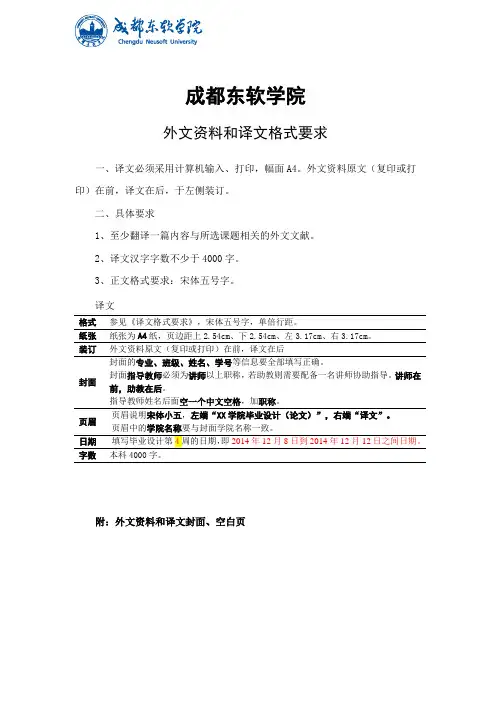
成都东软学院外文资料和译文格式要求一、译文必须采用计算机输入、打印,幅面A4。
外文资料原文(复印或打印)在前,译文在后,于左侧装订。
二、具体要求1、至少翻译一篇内容与所选课题相关的外文文献。
2、译文汉字字数不少于4000字。
3、正文格式要求:宋体五号字。
译文格式参见《译文格式要求》,宋体五号字,单倍行距。
纸张纸张为A4纸,页边距上2.54cm、下2.54cm、左3.17cm、右3.17cm。
装订外文资料原文(复印或打印)在前,译文在后封面封面的专业、班级、姓名、学号等信息要全部填写正确。
封面指导教师必须为讲师以上职称,若助教则需要配备一名讲师协助指导。
讲师在前,助教在后。
指导教师姓名后面空一个中文空格,加职称。
页眉页眉说明宋体小五,左端“XX学院毕业设计(论文)”,右端“译文”。
页眉中的学院名称要与封面学院名称一致。
字数本科4000字。
附:外文资料和译文封面、空白页成都东软学院外文资料和译文专业:软件工程移动互联网应用开发班级:2班姓名:罗荣昆学号:12310420216指导教师:2015年 12月 8日Android page layoutUsing XML-Based LayoutsW hile it is technically possible to create and attach widgets to our activity purely through Java code, the way we did in Chapter 4, the more common approach is to use an XML-based layout file. Dynamic instantiation of widgets is reserved for more complicated scenarios, where the widgets are not known at compile-time (e g., populating a column of radio buttons based on data retrieved off the Internet).With that in mind, it’s time to break out the XML and learn how to lay out Android activities that way.What Is an XML-Based Layout?As the name suggests, an XML-based layout is a specification of widgets’ relationships to each other—and to their containers (more on this in Chapter 7)—encoded in XML format. Specifi cally, Android considers XML-based layouts to be resources, and as such layout files are stored in the res/layout directory inside your Android project.Each XML file contains a tree of elements specifying a layout of widgets and their containers that make up one view hierarchy. The attributes of the XML elements are properties, describing how a widget should look or how a container should behave. For example, if a Button element has an attribute value of android:textStyle = "bold", that means that the text appearing on the face of the button should be rendered in a boldface font style.Android’s SDK ships with a tool (aapt) which uses the layouts. This tool should be automatically invoked by your Android tool chain (e.g., Eclipse, Ant’s build.xml). Of particular importance to you as a developer is that aapt generates the R.java source file within your project, allowing you to access layouts and widgets within those layouts directly from your Java code. Why Use XML-Based Layouts?Most everything you do using XML layout files can be achieved through Java code. For example, you could use setTypeface() to have a button render its textin bold, instead of using a property in an XML layout. Since XML layouts are yet another file for you to keep track of, we need good reasons for using such files.Perhaps the biggest reason is to assist in the creation of tools for view definition, such as a GUI builder in an IDE like Eclipse or a dedicated Android GUI designer like DroidDraw1. Such GUI builders could, in principle, generate Java code instead of XML. The challenge is re-reading the UI definition to support edits—that is far simpler if the data is in a structured format like XML than in a programming language. Moreover, keeping generated XML definitions separated from hand-written Java code makes it less likely that somebody’s custom-crafted source will get clobbered by accident when the generated bits get re-generated. XML forms a nice middle ground between something that is easy for tool-writers to use and easy for programmers to work with by hand as needed.Also, XML as a GUI definition format is becoming more commonplace. Microsoft’s XAML2, Adobe’s Flex3, and Mozilla’s XUL4 all take a similar approach to that of Android: put layout details in an XML file and put programming smarts in source files (e.g., JavaScript for XUL). Many less-well-known GUI frameworks, such as ZK5, also use XML for view definition. While “following the herd” is not necessarily the best policy, it does have the advantage of helping to ease the transition into Android from any other XML-centered view description language. OK, So What Does It Look Like?Here is the Button from the previous chapter’s sample application, converted into an XMLlayout file, found in the Layouts/NowRedux sample project. This code sample along with all others in this chapter can be found in the Source Code area of .<?xml version="1.0" encoding="utf-8"?><Button xmlns:android="/apk/res/android"android:id="@+id/button"android:text=""android:layout_width="fill_parent"android:layout_height="fill_parent"/>The class name of the widget—Button—forms the name of the XML element. Since Button is an Android-supplied widget, we can just use the bare class name. If you create your own widgets as subclasses of android.view.View, you would need to provide a full package declara tion as well.The root element needs to declare the Android XML namespace:xmlns:android="/apk/res/android"All other elements will be children of the root and will inherit that namespace declaration.Because we want to reference this button from our Java code, we need to give it an identifier via the android:id attribute. We will cover this concept in greater detail later in this chapter.The remaining attributes are properties of this Button instance:• android:text indicates the initial text to be displayed on the button face (in this case, an empty string)• android:layout_width and android:layout_height tell Android to have the button’swidth and height fill the “parent”, in this case the entire screen—these attributes will be covered in greater detail in Chapter 7.Since this single widget is the only content in our activity, we only need this single element. Complex UIs will require a whole tree of elements, representing the widgets and containers that control their positioning. All the remaining chapters of this book will use the XML layout form whenever practical, so there are dozens of other examples of more complex layouts for you to peruse from Chapter 7 onward.What’s with the @ Signs?Many widgets and containers only need to appear in the XML layout file and do not need to be referenced in your Java code. For example, a static label (TextView) frequently only needs to be in the layout file to indicate where it should appear. These sorts of elements in the XML file do not need to have the android:id attribute to give them a name.Anything you do want to use in your Java source, though, needs an android:id.The convention is to use @+id/... as the id value, where the ... represents your locally unique name for the widget in question. In the XML layout example in the preceding section, @+id/button is the identifier for the Button widget.Android provides a few special android:id values, of the form @android:id/.... We will see some of these in various chapters of this book, such as Chapters 8 and 10.We Attach These to the Java How?Given that you have painstakingly set up the widgets and containers in an XML layout filenamed main.xml stored in res/layout, all you need is one statement in your activity’s onCreate() callback to use that layout:setContentView(yout.main);This is the same setContentView() we used earlier, passing it an instance of a View subclass (in that case, a Button). The Android-built view, constructed from our layout, is accessed from that code-generated R class. All of the layouts are accessible under yout, keyed by the base name of the layout file—main.xml results in yout.main.To access our identified widgets, use findViewById(), passing in the numeric identifier of the widget in question. That numeric identifier was generated by Android in the R class asR.id.something (where something is the specific widget you are seeking). Those widgets are simply subclasses of View, just like the Button instance we created in Chapter 4.The Rest of the StoryIn the original Now demo, the button’s face would show the current time, which would reflect when the button was last pushed (or when the activity was first shown, if the button had not yet been pushed).Most of that logic still works, even in this revised demo (NowRedux). However,rather than instantiating the Button in our activity’s onCreate() callback, we can reference the one from the XML layout:package youts;import android.app.Activity;import android.os.Bundle;import android.view.View;import android.widget.Button; import java.util.Date;public class NowRedux extends Activity implements View.OnClickListener { Button btn;@Overridepublic void onCreate(Bundle icicle) { super.onCreate(icicle);setContentView(yout.main);btn=(Button)findViewById(R.id.button);btn.setOnClickListener(this);upd ateTime();}public void onClick(View view) { updateTime();}private void updateTime() {btn.setText(new Date().toString()); }}The first difference is that rather than setting the content view to be a view we created in Java code, we set it to reference the XML layout (setContentView(yout.main)). The R.java source file will be updated when we rebuild this project to include a reference to our layout file (stored as main.xml in our project’s res/l ayout directory).The other difference is that we need to get our hands on our Button instance, for which we use the findViewById() call. Since we identified our button as @+id/button, we can reference the button’s identifier as R.id.button. Now, with the Button instance in hand, we can set the callback and set the label as needed.As you can see in Figure 5-1, the results look the same as with the originalNow demo.Figure 5-1. The NowRedux sample activity Employing Basic WidgetsE very GUI toolkit has some basic widgets: fields, labels, buttons, etc. Android’s toolkit is no different in scope, and the basic widgets will provide a good introduction as to how widgets work in Android activities.Assigning LabelsThe simplest widget is the label, referred to in Android as a TextView. Like in most GUI toolkits, labels are bits of text not editable directly by users. Typically, they are used to identify adjacent widgets (e.g., a “Name:” label before a field where one fills in a name).In Java, you can create a label by creating a TextView instance. More commonly, though, you will create labels in XML layout files by adding a TextView element to the layout, with an android:text property to set the value of the label itself. If you need to swap labels based on certain criteria, such as internationalization, you may wish to use a resource reference in the XML instead, as will be described in Chapter 9. TextView has numerous other properties of relevance for labels, such as:• android:typeface to set the typeface to use for the label (e.g., monospace) • android:textStyle to indicate that the typeface should be made bold (bold), italic (italic),or bold and italic (bold_italic)• android:textColor to set the color of the label’s text, in RGB hex format (e.g., #FF0000 for red)For example, in the Basic/Label project, you will find the following layout file:<?xml version="1.0" encoding="utf-8"?><TextView xmlns:android=/apk/res/androidandroid:layout_width="fill_parent"android:layout_height="wrap_content"android:text="You were expecting something profound?" />As you can see in Figure 6-1, just that layout alone, with the stub Java source provided by Android’s p roject builder (e.g., activityCreator), gives you the application.Figure 6-1. The LabelDemo sample applicationButton, Button, Who’s Got the Button?We’ve already seen the use of the Button widget in Chapters 4 and 5. As it turns out, Button is a subclass of TextView, so everything discussed in the preceding section in terms of formatting the face of the button still holds. Fleeting ImagesAndroid has two widgets to help you embed images in your activities: ImageView and ImageButton. As the names suggest, they are image-based analogues to TextView and Button, respectively.Each widget takes an android:src attribute (in an XML layout) to specify what picture to use. These usually reference a drawable resource, described in greater detail in the chapter on resources. You can also set the image content based on a Uri from a content provider via setImageURI().ImageButton, a subclass of ImageView, mixes in the standard Button behaviors, for responding to clicks and whatnot.For example, take a peek at the main.xml layout from the Basic/ImageView sample project which is found along with all other code samples at : <?xml version="1.0" encoding="utf-8"?><ImageView xmlns:android=/apk/res/androidandroid:id="@+id/icon"android:layout_width="fill_parent"android:layout_height="fill_parent"android:adjustViewBounds="true"android:src="@drawable/molecule" />The result, just using the code-generated activity, is shown in Figure 6-2.Figure 6-2. The ImageViewDemo sample applicationFields of Green. Or Other Colors.Along with buttons and labels, fields are the third “anchor” of most GUI toolkits. In Android, they are implemented via the EditText widget, which is a subclass of the TextView used for labels.Along with the standard TextView properties (e.g., android:textStyle), EditText has many others that will be useful for you in constructing fields, including:• android:autoText, to control if the fie ld should provide automatic spelling assistance• android:capitalize, to control if the field should automatically capitalize the first letter of entered text (e.g., first name, city) • android:digits, to configure the field to accept only certain digi ts • android:singleLine, to control if the field is for single-line input or multiple-line input (e.g., does <Enter> move you to the next widget or add a newline?)Beyond those, you can configure fields to use specialized input methods, such asandroid:numeric for numeric-only input, android:password for shrouded password input,and android:phoneNumber for entering in phone numbers. If you want to create your own input method scheme (e.g., postal codes, Social Security numbers), you need to create your own implementation of the InputMethod interface, then configure the field to use it via android: inputMethod.For example, from the Basic/Field project, here is an XML layout file showing an EditText:<?xml version="1.0" encoding="utf-8"?><EditTextxmlns:android=/apk/res/androidandroid:id="@+id/field"android:layout_width="fill_parent"android:layout_height="fill_parent"android:singleLine="false" />Note that android:singleLine is false, so users will be able to enter in several lines of text. For this project, the FieldDemo.java file populates the input field with some prose:package monsware.android.basic;import android.app.Activity;import android.os.Bundle;import android.widget.EditText;public class FieldDemo extends Activity { @Overridepublic void onCreate(Bundle icicle) { super.onCreate(icicle);setContentView(yout.main);EditText fld=(EditText)findViewById(R.id.field);fld.setText("Licensed under the Apache License, Version 2.0 " + "(the \"License\"); you may not use this file " + "except in compliance with the License. You may " + "obtain a copy of the License at " +"/licenses/LICENSE-2.0");}}The result, once built and installed into the emulator, is shown in Figure 6-3.Figure 6-3. The FieldDemo sample applicationNote Android’s emulator only allows one application in the launcher per unique Java package. Since all the demos in this chapter share the monsware.android.basic package, you will only see one of these demos in your emulator’s launcher at any one time.Another flavor of field is one that offers auto-completion, to help users supply a value without typing in the whole text. That is provided in Android as the AutoCompleteTextView widget and is discussed in Chapter 8.Just Another Box to CheckThe classic checkbox has two states: checked and unchecked. Clicking the checkbox toggles between those states to indicate a choice (e.g., “Ad d rush delivery to my order”). In Android, there is a CheckBox widget to meet this need. It has TextView as an ancestor, so you can use TextView properties likeandroid:textColor to format the widget. Within Java, you can invoke: • isChecked() to determi ne if the checkbox has been checked• setChecked() to force the checkbox into a checked or unchecked state • toggle() to toggle the checkbox as if the user checked itAlso, you can register a listener object (in this case, an instance of OnCheckedChangeListener) to be notified when the state of the checkbox changes.For example, from the Basic/CheckBox project, here is a simple checkbox layout:<?xml version="1.0" encoding="utf-8"?><CheckBox xmlns:android="/apk/res/android"android:id="@+id/check"android:layout_width="wrap_content"android:layout_height="wrap_content"android:text="This checkbox is: unchecked" />The corresponding CheckBoxDemo.java retrieves and configures the behavior of the checkbox:public class CheckBoxDemo extends Activityimplements CompoundButton.OnCheckedChangeListener { CheckBox cb;@Overridepublic void onCreate(Bundle icicle) { super.onCreate(icicle);setContentView(yout.main);cb=(CheckBox)findViewById(R.id.check);cb.setOnCheckedChangeListener(this);}public void onCheckedChanged(CompoundButton buttonView,boolean isChecked) {if (isChecked) {cb.setText("This checkbox is: checked");}else {cb.setText("This checkbox is: unchecked");}}}Note that the activity serves as its own listener for checkbox state changes since it imple ments the OnCheckedChangeListener interface (via cb.setOnCheckedChangeListener(this)). The callback for the listener is onCheckedChanged(), which receives the checkbox whose state has changed and what the new state is. In this case, we update the text of the checkbox to reflect what the actual box contains.The result? Clicking the checkbox immediately updates its text, as you can see in Figures 6-4 and 6-5.Figure 6-4. The CheckBoxDemo sample application, with the checkbox uncheckedFigure 6-5. The same application, now with the checkbox checkedTurn the Radio UpAs with other implementations of radio buttons in other toolkits, Android’s radio buttons are two-state, like checkboxes, but can be grouped such that only one radio button in the group can be checked at any time.Like CheckBox, RadioButton inherits from CompoundButton, which in turn inherits fromTextView. Hence, all the standard TextView properties for font face, style, color, etc., are available for controlling the look of radio buttons. Similarly, you can call isChecked() on a RadioButton to see if it is selected, toggle() to select it, and so on, like you can with a CheckBox.Most times, you will want to put your RadioButton widgets inside of aRadioGroup. The RadioGroup indicates a set of radio buttons whose state is tied, meaning only one button out of the group can be selected at any time. If you assign an android:id to your RadioGroup in your XML layout, you can access the group from your Java code and invoke:• check() to check a specific radio button via its ID (e.g., group.check(R.id.radio1))• clearCheck() to clear all radio buttons, so none in the group are checked• getCheckedRadioButtonId() to get the ID of the currently-checked radio button (or -1 if none are checked)For example, from the Basic/RadioButton sample application, here is an XML layout showing a RadioGroup wrapping a set of RadioButton widgets: <?xml version="1.0" encoding="utf-8"?> <RadioGroupxmlns:android=/apk/res/androidandroid:orientation="vertical"android:layout_width="fill_parent"android:layout_height="fill_parent" ><RadioButton android:id="@+id/radio1"android:layout_width="wrap_content"android:layout_height="wrap_content"android:text="Rock" /><RadioButton android:id="@+id/radio2"android:layout_width="wrap_content"android:layout_height="wrap_content"android:text="Scissors" /><RadioButton android:id="@+id/radio3"android:layout_width="wrap_content"android:layout_height="wrap_content"android:text="Paper" /></RadioGroup>Figure 6-6 shows the result using the stock Android-generated Java forthe project and this layout.Figure 6-6. The RadioButtonDemo sample application Note that the radio button group is initially set to be completely unchecked at the outset. To pre-set one of the radio buttons to be checked, use either setChecked() on the RadioButton or check() on the RadioGroup from within your onCreate() callback in your activity.It’s Quite a ViewAll widgets, including the ones previously shown, extend View, and as such give all widgets an array of useful properties and methods beyond those already described.Useful PropertiesSome of the properties on View most likely to be used include:• Controls the focus sequence:• android:nextFocusDown• android:nextFocusLeft• android:nextFocusRight• android:nextFocusUp• android:visibility, which controls wheth er the widget is initially visible• android:background, which typically provides an RGB color value (e.g., #00FF00 for green) to serve as the background for the widgetUseful MethodsYou can toggle whether or not a widget is enabled via setEnabled() and see if it is enabled via isEnabled(). One common use pattern for this is to disable some widgets based on a CheckBox or RadioButton selection.You can give a widget focus via requestFocus() and see if it is focused via isFocused(). You might use this in concert with disabling widgets as previously mentioned, to ensure the proper widget has the focus once your disabling operation is complete.To help navigate the tree of widgets and containers that make up an activity’s overall view, you can use:• get Parent() to find the parent widget or container• findViewById() to find a child widget with a certain ID• getRootView() to get the root of the tree (e.g., what you provided to the activity via setContentView())Android 页面布局使用XML进行布局虽然纯粹通过Java代码在activity上创建和添加部件,在技术上是可行的,我们在第4章中做的一样,更常见的方法是使用一种基于XML的布局文件。
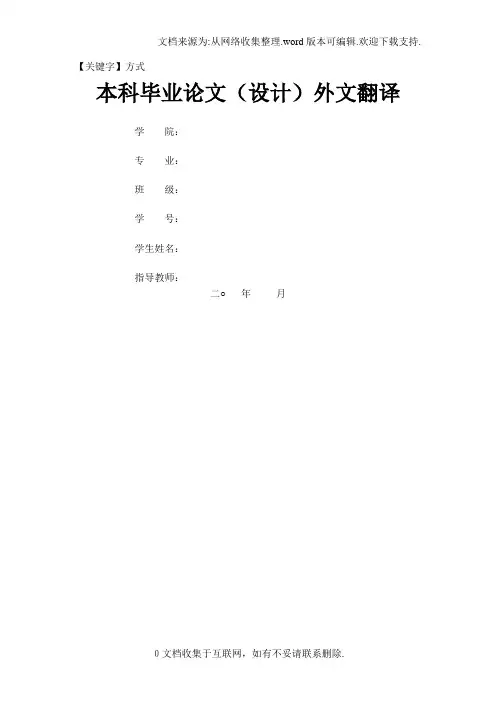
【关键字】方式本科毕业论文(设计)外文翻译学院:专业:班级:学号:学生姓名:指导教师:二○ 年月外文翻译之一外文原文题目(三号,Arial)作者:(外文,小四,times new roman)原文作者姓名标注方式全部姓名出处:(外文,小四,times new roman)期刊名,年份,卷(期):页码,如书等其他文献参照正文参照文献标注方式外文翻译之二外文原文题目(三号,Arial)作者:(外文,小四,times new roman)原文作者姓名标注方式全部姓名出处:(外文,小四,times new roman)期刊名,年份,卷(期):页码,如书等其他文献参照正文参照文献标注方式外文原文(可附pdf原件),装订次序为原文1,译文1,原文2,译文2.两篇译文可单独编页码顺序.译文1中文译文题目(三号,黑体/Arial)作者:(五号,times new roman,外文)出处:(五号,times new roman,外文)摘要(加粗):(中文宋体英文times new roman五号,行距1.5倍)关键词(加粗):(中文宋体英文times new roman五号,行距1.5倍,关键词之间使用分号间隔)译文正文中文宋体英文times new roman,小四,行距1.5倍;标题小四加粗顶格正文小四;表图题五号字体加粗单倍行距。
表图文及注五号字体不加粗单倍行距。
其余未说明的格式要求可按照指导教师要求为准。
译文2中文译文题目(三号,黑体)作者:(五号,英文times new roman)出处:(五号,英文times new roman)摘要(加粗):(中文宋体英文times new roman五号,行距1.5倍)关键词(加粗):(中文宋体英文times new roman五号,行距1.5倍,关键词之间使用分号间隔)译文正文中文宋体英文times new roman,小四,行距1.5倍;标题小四加粗顶格正文小四;表图题五号字体加粗单倍行距。
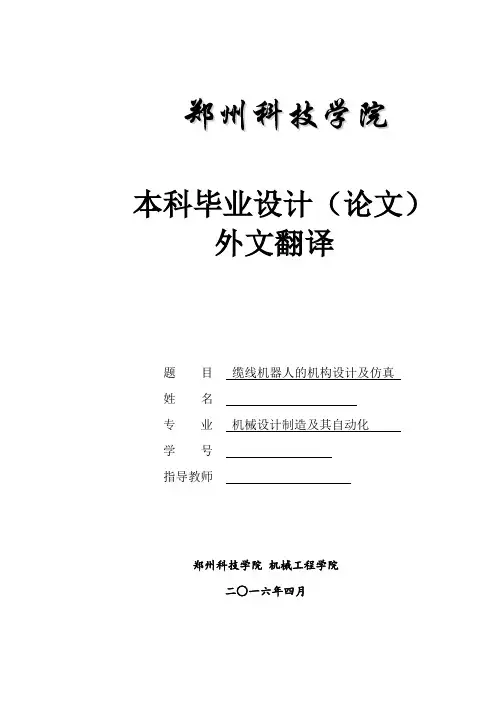
本科毕业设计(论文)外文翻译题目缆线机器人的机构设计及仿真姓名专业机械设计制造及其自动化学号指导教师郑州科技学院机械工程学院二○一六年四月基于分层生物反射的自适应行走的四足机器人张秀丽 ,1,明成1,曾翔宇1,郑浩峻21学校的机械,电子与控制工程,北京交通大学,北京100044,中国2精密仪器系,清华大学,北京100084,中国2011年1月27日收到; 2012年3月19日修订;2012年3月22日接受摘要:多条腿的机器人是一种利用自身的动态模型来控制的传统控制模型的机器人。
当机器人面临崎岖的地形和未知环境时,以这种动态模型为基础的方法却不能获得满意的性能。
提到动物的神经控制机制,控制模型的建立就是为了四足机器人的自适应行走。
机器人的基本节奏的运动是由一个精心设计的有节奏的运动控制器控制(RMC),这种运动控制器包括针对髋关节的中枢模式发生器(CPG)和针对膝关节的有节奏的耦合器(RC)。
CPG和RC的关系就像有运动映射和韵律的夫妇。
多感官的电机模型,抽象于一只猫的神经反射,从而被采用。
这些反射模型进行组织并与CPG在三层交流反应,以满足复杂的要求和时间响应的任务。
在RMC与层状生物反射的基础上,四足机器人得以构造,它可以清除障碍,自主性地爬上坡和走下坡,并在不确定的环境下主动转向,以类似的方式与动物环境相互作用。
本文提供了一个受生物启发的体系结构,其中一个机器人能自适应地用一个简单而有效的方法在不确定的环境中行走,并实现更好的性能。
关键词:四足机器人;运动控制;中枢模式发生器(CPG);生物反射1引言一个自主机器人控制系统必须完成许多复杂的任务,集成不同传感器的信息并实时性和复杂性的适应不同的功能。
多机器人控制系统集成感觉输入和制动器的输出以实现非结构化环境中的一个优秀的运动能力仍是一个争议以及在机器人技术和人工智能领域方面的一大挑战(AI)。
根据布鲁克斯[]1,已经开发了两种方法使腿式机器人在非结构化环境中取得令人满意的性能。
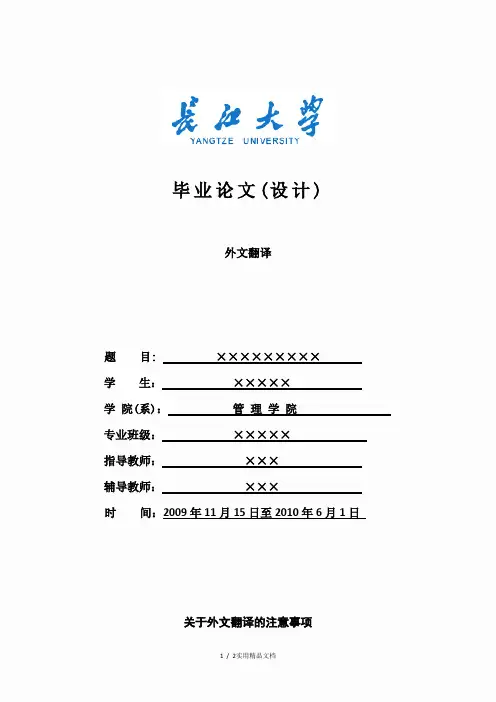
毕业论文(设计)
外文翻译
题目: ×××××××××
学生:×××××
学院(系):管理学院
专业班级:×××××
指导教师:×××
辅导教师:×××
时间:2009年11月15日至2010年6月1日
关于外文翻译的注意事项
1.单独装订成册;
2.装订顺序:译文在前,原文在后;
3.译文不少于3000汉字;
4.封面中的“题目”是译文题目;
5.本册的页眉:译文用译文题目,原文用原文题目。
不需要分奇偶页。
6.译文排版:
(1)字号——宋体、小四;
(2)行距——固定值22磅;
(3)段前、段后一律为0行。
7.原文排版:
(1)字号——TimesNewRoman;
(2)行距——固定值22磅;
(3)段前、段后一律为0行。
【此课件下载可自行编辑修改,供参考,感谢你的支持!】。
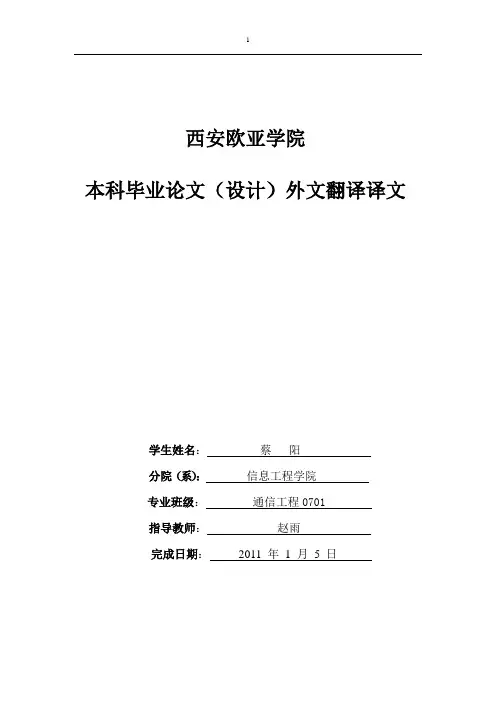
西安欧亚学院本科毕业论文(设计)外文翻译译文学生姓名:蔡阳分院(系):信息工程学院专业班级:通信工程0701指导教师:赵雨完成日期:2011 年1 月5 日不能触碰这个—无线电力传输Can't Touch This—Wireless power transmission作者:Bill Weaver, Ph.D.起止页码:出版日期(期刊号):2006年10月25日出版单位:(以上文字用小4号宋体,数字、字母用Times New Roman体)外文翻译译文:几年前,一个同事和我参加在校大学生团体的一个老式的实地考察,考察地位于新泽西州的爱迪生国家历史遗址的西橙。
我们随公众参观,并参观了设置于建筑物内的实验室,了解了白炽灯灯泡和电影技术的发展。
然而,令我最感动的是其中的两个复杂的附加功能。
首先,是配备了当时美国专利局的所有出版物的研究图书馆。
科学家和工程师的代表关注到适销对路的产品可能会在创造新技术中有所用途。
大学是随之而来的发现科学技术的伟大场所,但爱迪生的实验室却是作为一个企业而存在的。
在 19 世纪后期是没有互联网连接的,因此,图书馆便担任起了实验室的信息存储库。
就像今天,当研究人员所需要的信息是有关于化学反应、一个数学公式或他们最先进的工程解决方案而咨询目前的文献一样,只不过当时是通过纸张。
第二个令人印象深刻的事情是生产和加工设施的复杂性。
创建工具,使新的工具催化技术的发展,是爱迪生实验室的一个创新过程的早期代表性的例子。
通过快速采用标准,进一步简化此过程。
由于工具和设备大部分可以在本地发展,便可以在数英亩大小的校园中部署自己的标准并创造该设施。
这种标准之一是权力分配的方法。
最终已知的电网发展供电是著名的爱迪生灯泡,早期的爱迪生实验室使用的工具是由一个通用线路轴组成的机器。
组成一个类似于后轮驱动汽车传动轴的长旋转轴或像是一个海洋船只的螺旋桨轴,使整个工厂的旋转的势能形式分散了锅炉产生的机械能。
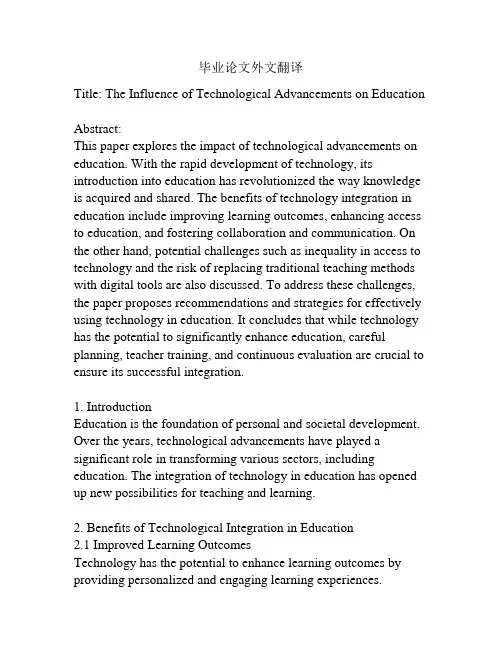
毕业论文外文翻译Title: The Influence of Technological Advancements on Education Abstract:This paper explores the impact of technological advancements on education. With the rapid development of technology, its introduction into education has revolutionized the way knowledge is acquired and shared. The benefits of technology integration in education include improving learning outcomes, enhancing access to education, and fostering collaboration and communication. On the other hand, potential challenges such as inequality in access to technology and the risk of replacing traditional teaching methods with digital tools are also discussed. To address these challenges, the paper proposes recommendations and strategies for effectively using technology in education. It concludes that while technology has the potential to significantly enhance education, careful planning, teacher training, and continuous evaluation are crucial to ensure its successful integration.1. IntroductionEducation is the foundation of personal and societal development. Over the years, technological advancements have played a significant role in transforming various sectors, including education. The integration of technology in education has opened up new possibilities for teaching and learning.2. Benefits of Technological Integration in Education2.1 Improved Learning OutcomesTechnology has the potential to enhance learning outcomes by providing personalized and engaging learning experiences.Interactive multimedia resources, such as videos, simulations, and virtual reality, can make complex concepts more accessible and understandable for students. Additionally, learning management systems and online platforms enable students to access educational materials anytime and anywhere, facilitating self-paced learning. 2.2 Enhanced Access to EducationTechnology has greatly expanded access to education, especially in remote and underserved areas. Online courses, virtual classrooms, and open educational resources have democratized education, allowing individuals to overcome geographical barriers and access learning opportunities that were previously unavailable. Furthermore, technology has created opportunities for lifelong learning, making education more accessible to adults and professionals.2.3 Collaboration and CommunicationTechnology enables collaboration and communication among students, teachers, and experts from different locations. Online discussion forums, video conferencing, and collaborative tools promote active participation, peer learning, and knowledge sharing. These digital platforms also facilitate communication between teachers and students, providing instant feedback and support outside of the traditional classroom settings.3. Challenges and ConcernsDespite the numerous benefits, there are challenges and concerns associated with technology integration in education.3.1 Inequality in Access to TechnologyThe digital divide creates unequal access to technology, making it difficult for some students to fully benefit from technology in their educational journey. Limited access to devices, stable internet connection, and technology literacy are major barriers that need to be addressed to ensure equal opportunities for all learners.3.2 Potential Over-reliance on TechnologyThere is a risk of over-reliance on technology, leading to the exclusion of effective traditional teaching methods or neglecting essential skills, such as critical thinking and problem-solving. It is important to strike a balance between technology use and traditional teaching approaches, ensuring that technology complements and enhances, rather than replaces, the core aspects of education.4. Recommendations and StrategiesTo harness the potential of technology in education, it is important to consider the following recommendations and strategies:4.1 Infrastructure and AccessEfforts should be made to bridge the digital divide by providing infrastructure, such as devices and internet connectivity, to underserved communities. Schools and educational institutions should prioritize equal access to technology and ensure that students have the necessary skills to utilize it effectively.4.2 Teacher Training and Professional DevelopmentTeachers play a critical role in integrating technology into the curriculum. Adequate training and professional development programs are essential to equip teachers with the skills andknowledge to effectively use technology for teaching and learning purposes. Continuous support and opportunities for collaboration and sharing of best practices should be provided.4.3 Continuous Evaluation and AdaptationRegular evaluation and feedback mechanisms should be in place to assess the impact of technology integration on learning outcomes. This will help identify areas for improvement and adapt teaching practices accordingly. Continuous evaluation will also ensure that the integration of technology remains aligned with educational goals and objectives.5. ConclusionTechnology has the potential to reshape education in unprecedented ways. This paper has highlighted the benefits and challenges of technology integration in education. It is essential to recognize that technology is a tool, not a substitute for quality teaching and learning. Strategic planning, teacher training, and evaluation are necessary to ensure technology's effective integration into education, thus harnessing its full potential to improve learning outcomes, enhance access to education, and foster collaboration and communication.。
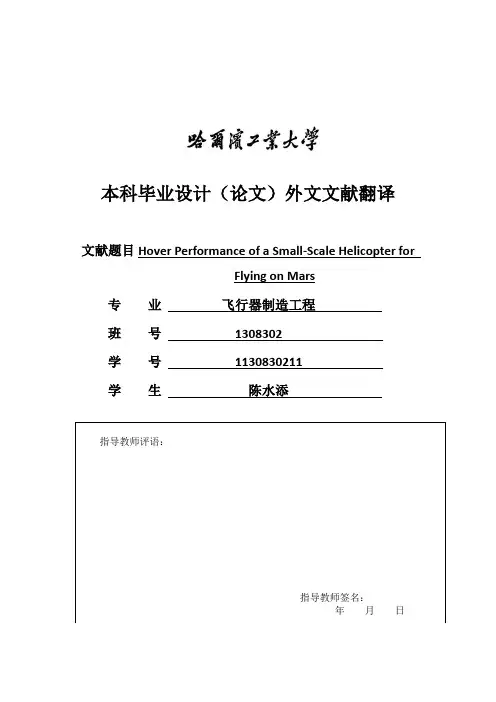
本科毕业设计(论文)外文文献翻译文献题目Hover Performance of a Small-Scale Helicopter forFlying on Mars专业飞行器制造工程班号1308302学号**********学生陈水添可用于火星飞行的小型直升机转子悬停性能Robin ShresthaUniversity of Maryland, College Park, Maryland 20742Moble BenedictTexas A&M University, College Station, Texas 77843以及Vikram Hrishikeshavan 和Inderjit Chopra§University of Maryland, College Park, Maryland 20742DOI:10.2514/1.C033621摘要:本研究是为了回应对于评估用于火星探测的小型自动化直升机(总质量小于1 kg)飞行可行性与日俱增的兴趣。
自主旋翼航空器可以理想地适用于这样的应用,因为它具有独特的优点,其中包括在与传统的地面漫游器相比时在恶劣的地形上垂直起飞/着陆的能力以及更大的速度,范围和视野。
火星上的大气条件呈现出独特的设计挑战。
尽管火星的重力只有38%左右地球的重力,火星的平均大气密度是地球大气密度的七十分之一。
因此,转子将以非常低的雷诺数运行,对于小型直升机而言,甚至低于5000。
然而,由于需要更高的尖端速度(由于密度较低),马赫数将显着更高(M> 0.4),并且由于火星上的声速仅为地球声速的大约72%。
桨叶上的低雷诺数,高马赫数流动条件对转子设计施加了严格的限制。
本研究提出的解决方案涉及扩大转子尺寸以在可接受的马赫数和雷诺数条件下产生所需的推力。
实验在一个真空室中评估了200 g火星同轴直升机的全尺寸转子的悬停性能,真空室完全模拟了火星空气密度。
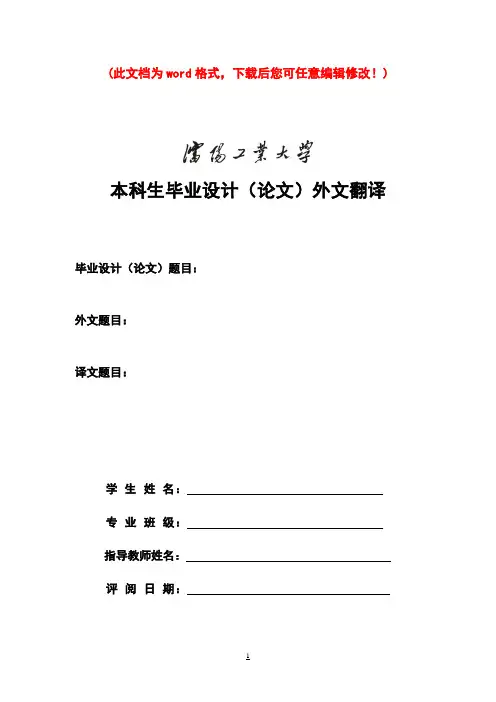
1
(此文档为word格式,下载后您可任意编辑修改!)
本科生毕业设计(论文)外文翻译
毕业设计(论文)题目:
外文题目:
译文题目:
学 生 姓 名:
专 业 班 级:
指导教师姓名:
评 阅 日 期:
2
英文翻译指导教师评阅意见
指导教师签字:
年 月 日
絮凝:污泥性质和废水处理的影响摘要进行研究,以确定在激活的絮凝作用污泥单元过程。
实验室和完整的大型研究显示,絮凝最重要的,在于确定沉淀,脱水,污水和消化污泥特性(活性污泥属性),并可能涉及到的所有进程的功能是至关重要的。
在这些研究中,结果表明,二价阳离子,如钙和镁改善活性污泥的性质,而单价阳离子如如钠,钾和铵离子,不利于这些属性. “二价阳离子通过衔接机制,促进负责絮凝带负电荷的生物大分子(主要是蛋白质和多糖).结果发现,氧化铁起着重大作用,在活性污泥的絮凝和决心通过铁和生物大分子之间的表面相互作用的性质。
氧化铁有效地消除从凝固的胶体溶液聚合物和空调的研究.这项研究包括钾的实验评估影响沉降和脱水性能和铵离子,镁的影响沉降性能;影响钠,钾,钙和镁的废水质量;固体停留时间,对出水水质的影响;絮状物评估在有氧和高温消化的属性。
一个絮状物模型中提出钙,镁,铁絮凝的功能是很重要曝气池,沉淀池,脱水设备和好氧或厌氧沼气池.结果表明,活性污泥絮状物性能的影响废水处理效率.关键词:阳离子,活性污泥,沉淀,脱水,镁,铵。
前言活性污泥是由微生物财团和胞外聚合物和二价阳离子(手冢,1969年形成了矩阵一起举行的有机和无机粒子;诺瓦克和豪根,1981年埃里克森和ALM,1991; Bruus等,1992;希金斯和诺瓦克,1997年,B)。
bruus等人. (1992年)和希金斯和诺瓦克(1997年b)表明,多余的单价阳离子可引起中絮状物的恶化结构和沉降性能。
观察与二价阳离子的增加沉降性能的改善.许多工业系统需要高纯度的进水.因此,除了规定的化学品在工业过程和废水预处理的废水进入激活污泥盆地的阳离子组成。
这些废水通常会在一些阳离子缺陷,将包含他人的过多.单价离子的增加导致活性污泥脱水性能的恶化,而二价离子的增加已被证明可以改善活性污泥脱水性能希金斯和诺瓦克,1997,(二)已被观察到。
这些意见进行了实验室和工业系统中活性污泥絮体。
长江大学工程技术学院毕业设计(论文)外文翻译Matlab Based Interactive Simulation Program 外文题目for 2D Multisegment Mechanical Systems二维多段机械系统基于Matlab的译文题目交互式仿真程序系部化学工程系专业班级化工60801学生姓名李泽辉指导教师张铭辅导教师张铭完成日期2012.4.15二维多段机械系统基于Matlab的交互式仿真程序Henryk Josiński, Adam Świtoński, Karol Jędrasiak著;李泽辉译摘要:本文介绍了多段机械系统设计原则,代表的是一个模型的一部分的设计系统,然后扩展形成的几个部分和模型算法的分类与整合的过程,以及简化步骤的过程叫多段系统。
本文还介绍了设计过程的二维多段机械系统的数字模型,和使用Matlab的软件包来实现仿真。
本文还讨论测试运行了一个实验,以及几种算法的计算,实现了每个单一步骤的整合。
1 简介科学家创造了物理模型和数学模型来表示人类在运动中的各种形式。
数学模型使创建数字模型和进行计算机仿真成为可能。
模型试验,可以使人们不必真正的实验就可以虚拟的进行力和力矩的分解。
本文研究的目的是建立一个简单的多段运动模型,以增加模型的连续性和如何避免不连续为原则。
这是创建一个人类运动模型系统的冰山一角。
其使用matlab程序包创建的数字模型,可以仿真人类运动。
文献中关于这一主题的内容很广泛。
运动的模式和力矩的分解在这些文献中都有涉猎。
动态的平面人体运动模型,提出了解决了迭代矩阵的方法。
还值得一提的是这类项目的参考书目,布鲁贝克等人提出了一个模型——人腿模型,这个以人的物理运动为基础的平面模型仿真了人腿——一个单一的扭簧和冲击碰撞模型。
人腿模型虽然简单,但是它展示人类的步态在水平地面上的运动特征。
布鲁贝克等人还介绍,在人腿模型的双足行走的基础上,从生物力学的角度而言,符合人体步行的特征。
毕业设计(论文)——外文翻译(原文)NEW APPLICATION OF DATABASERelational databases in use for over two decades. A large portion of the applications of relational databases in the commercial world, supporting such tasks as transaction processing for banks and stock exchanges, sales and reservations for a variety of businesses, and inventory and payroll for almost of all companies. We study several new applications, which recent years.First. Decision-support systemAs the online availability of data , businesses to exploit the available data to make better decisions about increase sales. We can extract much information for decision support by using simple SQL queries. Recently support based on data analysis and data mining, or knowledge discovery, using data from a variety of sources.Database applications can be broadly classified into transaction processing and decision support. Transaction-processing systems are widely used today, and companies generated by these systems.The term data mining refers loosely to finding relevant information, or “discovering knowledge,” from a large volume of data. Like knowledge discovery in artificial intelligence, data mining attempts to discover statistical rules and patterns automatically from data. However, data mining differs from machine learning in that it deals with large volumes of data, stored primarily on disk.Knowledge discovered from a database can be represented by a set of rules. We can discover rules from database using one of two models:In the first model, the user is involved directly in the process of knowledge discovery.In the second model, the system is responsible for automatically discovering knowledgefrom the database, by detecting patterns and correlations in the data.Work on automatic discovery of rules influenced strongly by work in the artificial-intelligence community on machine learning. The main differences lie in the volume of data databases, and in the need to access disk. Specialized data-mining algorithms developed to which rules are discovered depends on the class of data-mining application. We illustrate rule discovery using two application classes: classification and associations.Second. Spatial and Geographic DatabasesSpatial databases store information related to spatial locations, and provide support for efficient querying and indexing based on spatial locations. Two types of spatial databases are particularly important:Design databases, or computer-aided-design (CAD) databases, are spatial databases used to store design information about databases are integrated-circuit and electronic-device layouts.Geographic databases are spatial databases used to store geographic information, such as maps. Geographic databases are often called geographic information systems.Geographic data are spatial in nature, but differ from design data in certain ways. Maps and satellite images are typical examples of geographic data. Maps may provide not only location information -such as boundaries, rivers and roads---but also much more detailed information associated with locations, such as elevation, soil type, land usage, and annual rainfall.Geographic data can be categorized into two types: raster data (such data consist a bit maps or pixel maps, in two or more dimensions.), vector data (vector data are constructed from basic geographic objects). Map data are often represented in vector format.Third. Multimedia DatabasesRecently, there much interest in databases that store multimedia data, such as images, audio, and video. Today multimedia data typically are stored outside the database, in files systems. When the number of multimedia objects is relatively small, features provided by databases are usually not important. Database functionality becomes important when the number of multimedia objects stored is large. Issues such as transactional updates, querying facilities, and indexing then become important. Multimedia objects often they were created, who created them, and to what category they belong. One approach to building a database for such multimedia objects is to use database for storing the descriptive attributes, and for keeping track of the files in which the multimedia objects are stored.However, storing multimedia outside the database makes it the basis of actual multimedia data content. It can also lead to inconsistencies, such a file that is noted in the database, but whose contents are missing, or vice versa. It is therefore desirable to store the data themselves in the database.Forth. Mobility and Personal DatabasesLarge-scale commercial databases stored in central computing facilities. In the case of distributed database applications, there strong central database and network administration. Two technology trends which this assumption of central control and administration is not entirely correct:1.The increasingly widespread use of personal computers, and, more important, of laptop or “notebook” computers.2.The development of a relatively low-cost wireless digital communication infrastructure, base on wireless local-area networks, cellular digital packet networks, and other technologies.Wireless computing creates a situation where machines no longer at which to materialize the result of a query. In some cases, the location of the user is a parameter of the query. A example is a traveler’s information system that provides data on the current route must be processed based on knowledge of the user’s location, direction of motion, and speed.Energy (battery power) is a scarce resource for mobile computers. This limitation influences many aspects of system design. Among the more interesting consequences of the need for energy efficiency is the use of scheduled data broadcasts to reduce the need for mobile system to transmit queries. Increasingly amounts of data may reside on machines administered by users, rather than by database administrators. Furthermore, these machines may, at times, be disconnected from the network.SummaryDecision-support systems are gaining importance, as companies realize the value of the on-line data collected by their on-line transaction-processing systems. Proposed extensions to SQL, such as the cube operation, of summary data. Data mining seeks to discover knowledge automatically, in the form of statistical rules and patterns from large databases. Data visualization systems data as well as geographic data. Design data are stored primarily as vector data; geographic data consist of a combination of vector and raster data.Multimedia databases are growing in importance. Issues such as similarity-based retrieval and delivery of data at guaranteed rates are topics of current research.Mobile computing systems , leading to interest in database systems that can run on such systems. Query processing in such systems may involve lookups on server database.毕业设计(论文)——外文翻译(译文)数据库的新应用我们使用关系数据库已经有20多年了,关系数据库应用中有很大一部分都用于商业领域支持诸如银行和证券交易所的事务处理、各种业务的销售和预约,以及几乎所有公司都需要的财产目录和工资单管理。
外文翻译模板(总12页)--本页仅作为文档封面,使用时请直接删除即可----内页可以根据需求调整合适字体及大小--杭州电子科技大学毕业论文外文文献翻译要求根据《普通高等学校本科毕业设计(论文)指导》的内容,特对外文文献翻译提出以下要求:一、翻译的外文文献可以是一篇,也可以是两篇,但总字符要求不少于万(或翻译成中文后至少在3000字以上)。
二、翻译的外文文献应主要选自学术期刊、学术会议的文章、有关着作及其他相关材料,应与毕业论文(设计)主题相关,并作为外文参考文献列入毕业论文(设计)的参考文献。
并在每篇中文译文标题尾部用“脚注”形式注明原文作者及出处,中文译文后应附外文原文(全文,格式为word)。
不能翻译中国学者的文章,不能翻译准则等有译文的着作。
三、中文译文的基本撰写格式1.题目:采用小三号、黑体字、居中打印;段前二行,段后二行。
2.正文:采用小四号、宋体字,行间距一般为固定值20磅,标准字符间距。
页边距为左3cm,右,上下各,页面统一采用A4纸。
四、外文原文格式1.题目:采用小三号、Times New Roman、居中打印;段前二行,段后二行。
2.正文:采用小四号、Times New Roman,行间距一般为固定值20磅,标准字符间距。
页边距为左3cm,右,上下各,页面统一采用A4纸。
五、封面格式由学校统一制作(注:封面上的“翻译题目”指中文译文的题目),并按“封面、封面、译文、外文原文、考核表”的顺序统一装订。
毕业论文外文文献翻译毕业论文题目Xxx翻译题目指翻译后的中文译文的题目学院会计学院(以本模板为准)专业XXXXXX(以本模板为准)姓名XXXXXX(以本模板为准)班级XXXXXX(以本模板为准)学号XXXXXX(以本模板为准)指导教师XXXXXX(以本模板为准)译文管理者过度乐观与债务、股权融资之间的选择1本文采取了一家成长较快速的公司作为样本,比较债务融资和股权融资后的长期股票业绩。
本科生毕业设计(论文)外文翻译毕业设计(论文)题目:
外文题目:
译文题目:
学院:软件学院
专业:计算机科学与技术
学生姓名:李世民
学生班级:计算机2+20301班
指导教师:唐伯虎秦琼
注意事项:
1.封面填写各项均为打印。
2.纸张A4,上下页边距2.54,左边3.0,右边2.5。
3.文章题目:中文黑体3号加粗。
英文3号Times New Roman,加粗4.文中各级标题:中文4号黑体,加粗。
英文4号Times New Roman,加粗。
标题段前段后为0.5行,单倍行距。
5.正文:中文宋体小四。
英文Times New Roman,小四。
段前段后为0行,1.5倍行距。
6.中英文为1.5行距。
7.英文原文在前,中文译文在后;英文、中文独立成章。
外文翻译题目:大豆高光效育种研究进展摘要:多年的研究证明,提高光合效率是提高大豆产量的重要途径。
在高产条件下,高光效大豆(Ghycine max L.Merr.)品种与一般品种相比可提高产量30%~40%,表明高光效育种有着广阔的发展前景。
高光效育种虽然未能缩短育种时间,但为达到预定的高光效目标提供了“实时”监测,C 4C 4途径酶的表达能力,可能是提高C 3植物光关键词光合作用是决定作物产量的最重要的因素之一[1-3],因为大于90%的作物干物重直接来自于光合作用。
这意味着,在农业生产中,光合效率直接关系到最终产量。
因此,许多国家的研究人员已经积极地参与到新的育种方法的研究中,目的是改善作物的光合能力[4,5],并且通过我们长期在不同发育阶段采取多种措施以提高作物生产潜力的研究,高光效育种已经被视为重要的方法之一。
在过去的二十年里,通过植物生理学家和基因学家的密切科学合作,中国研究人员已经采取许多不同手段,广泛地研究了个别作物增加产量的潜力,并且已经取得了明显进展。
这篇文章是对我们以前在大豆高光效育种研究以及其他研究者的相关工作的简短回顾。
不同的光合参数,例如光截获能力、光能转换效率、碳同化作用和光合特性的遗传等等,都有待讨论。
1.光合率与产量潜力之间的关系虽然光合率一般用于高光效的指示,但光合率与产量之间是否确实有相关性还在争论中。
在中国,自从1970年以来,许多研究者探索这种相关性。
张贤泽和马占峰[6]发现,在最近精选的大豆品种中,叶片光合率和产量都高于以前的品种。
游明安[7]在不同的大豆品种间通过群体分析描述了相似的倾向。
我们的研究证明,在大豆结荚期,功能叶的光合率与产量之间有确实的相关性[8,9]。
例如,三种最近精选出的高光效品种黑农39,40和41,各自与其亲本相比在光合率上增加25.0%,18.0%和41.0%,在子粒产量上增加39.1%,36.0%和37.3%。
需要指出的是,所有这些结果是通过生育期相似的不同品种的光合率相比较而获得的。
本科生毕业设计 (论文)
外 文 翻 译
原 文 标 题
Our Country Commercial Bank Financial
Control’s Reform Innovates
译 文 标 题 我国商业银行的财务管理的改革创新
作者所在系别 会计系
作者所在专业 财务管理
作者所在班级 B11622
作 者 姓 名 张昊
作 者 学 号 20114062235
指导教师姓名 李娅捷
指导教师职称 教授
完 成 时 间 2014 年 12 月 30日
北华航天工业学院教务处制
此页无页码
整篇文档通用的页面设置参数
为:A4打印纸(29.7厘米×21
厘米)。英文及阿拉伯数字字体均
为Times New Roman。页面左页
边距为2.5厘米、右页边距为2.2
厘米,上下页边距各2厘米。页
眉距边界1.5厘米,页脚距边界
1.5厘米。
本页空白单元
格格式均为:宋
体(汉字),小
四号,单元格内
居中对齐。段落
设置为:单倍行
距,段前0行,
段后0行。其
他所有内容请
不要做任何改
动。
译文标题
原文标题
作 者 译 名 国 籍
原文出处
自本页开始设置页码,页码在页脚居中设
置,用阿拉伯数字编排,格式为:宋体(汉
字)、小五号,居中对齐。页脚距边界1.5
厘米。
前四行的信息栏格式为:宋体(中文),小四号字,居中对齐,段落设置为:单
倍行距,段前0行,段后0行。
原文出
处的书
写格式
同论文
的参考
文献
正文全文为3,000个汉字以上。
第一行文字前留一空行。
正文格式:宋体(中文),小四号字,
两端对齐,
段落开头空两个字(即首行缩进2
字符),
行距为固定值20磅,段前0行,
段后0行。
指 导 教 师 评 语
外文翻译成绩:
指导教师签字:
年 月 日
注:1. 指导教师对译文进行评阅时应注意以下几个方面:①翻译的外文文献与毕业设计(论文)的主题是
否高度相关,并作为外文参考文献列入毕业设计(论文)的参考文献;②翻译的外文文献字数是否
达到规定数量(3 000字以上);③译文语言是否准确、通顺、具有参考价值。
2. 外文原文应以附件的方式置于译文之后。
本页内
容全部
由指导
教师手
写
成绩以百分数来表示